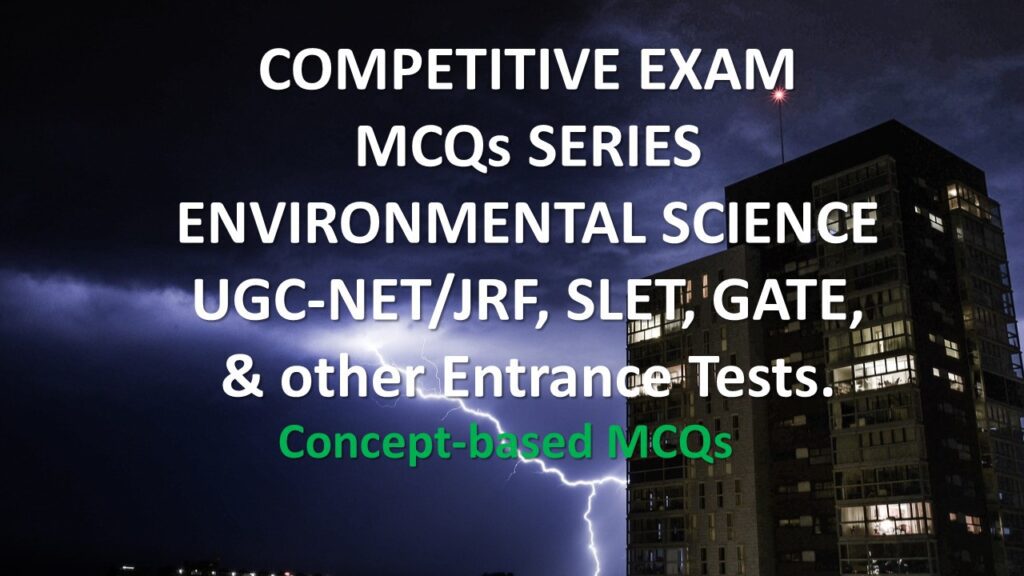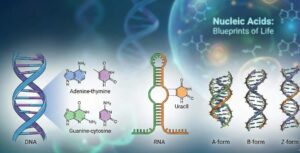
Welcome to the COMPETITIVE EXAM MCQs SERIES of ENVIRONMENTAL SCIENCE for UGC-NET/JRF, SLET, GATE, and other entrance tests – Meteorological Parameters.
The topic of Meteorological Parameters in Environmental Science focuses on the study of various atmospheric elements and their measurements. It is crucial for understanding weather patterns, climate change, and environmental processes. Therefore, it is an important subject for competitive examinations.
Syllabus outline
- Definition and scope of meteorology in the context of environmental science.
- Historical development and key contributors to the field of meteorology.
- Concepts of temperature, heat, and specific heat capacity.
- Relative humidity, absolute humidity, and specific humidity.
- Dew point, vapour pressure, and various humidity measuring devices.
- Types of precipitation: (e.g. rain, snow, sleet, hail).
- Measurement methods for precipitation, (e.g. rain gauges, snow gauges, atmospheric pressure and its variation with altitude).
- Wind patterns, global circulation, wind speed and direction, solar radiation, and its interaction with the atmosphere.
- Measurement of solar radiation and its significance in environmental processes.
- Evaporation processes from various surfaces and their importance in hydrological cycles.
- Understanding weather systems (e.g. cyclones, anticyclones, and fronts), weather maps and forecasting techniques.
- Factors influencing microclimates and their significance in local weather patterns.
- Urban heat island effect and its impact on urban environments.
This quiz contains the concept-based most frequently asked 25 MCQs of “Meteorological Parameters“. Each question has a single correct/most appropriate answer.
1. In certain regions, the concentration of water vapour in the atmosphere may be as high as ___%.
a) 34
b) 24
c) 4
d) 14
2. The Coriolis effect is responsible for:
a) Atmospheric pressure variations
b) Temperature fluctuations
c) Wind patterns
d) Humidity changes
3. The term atmospheric stability refers to:
a) The ability of the atmosphere to absorb solar radiation
b) The level of air pollution in a particular area
c) The ability of the atmosphere to transport pollutants
d) The resistance of the atmosphere to vertical motion
4. The wind direction is reported as the:
a) Direction toward which the wind is blowing
b) Speed of the wind
c) Direction from which the wind is blowing
d) Temperature of the wind
5. The Beaufort scale is used to measure:
a) Atmospheric pressure
b) Temperature
c) Wind speed
d) Humidity
6. The ozone hole is most prominent over:
a) Africa
b) North America
c) Europe
d) Antarctica
7. The term doldrums refers to:
a) A region with low atmospheric pressure
b) A region with extremely high atmospheric pressure
c) A region characterized by high winds and frequent storms
d) An area near the equator with calm winds and little atmospheric circulation
8. The term wind chill factor refers to:
a) The decrease in temperature caused by the reflection of solar radiation by snow and ice
b) The perceived decrease in temperature caused by the combination of wind and low temperatures
c) The decrease in temperature caused by the absence of wind
d) The increase in temperature caused by the presence of warm winds
9. Assertion (A): The Coriolis effect is responsible for wind deflection patterns in the Earth’s atmosphere.
Reasoning (R): The rotation of the Earth causes moving air masses to be deflected to the right in the Northern Hemisphere and the left in the Southern Hemisphere.
a) The A is incorrect, but the R is correct.
b) The A is correct, but the R is incorrect.
c) Both the A and R are correct, but the R is not the correct explanation of the A.
d) Both the A and R are correct, and the R is the correct explanation of the A.
10. The term thermal pollution refers to:
a) The release of excess heat into water bodies, leading to ecological disruptions
b) The release of toxic chemicals into the atmosphere, causing health problems
c) The depletion of the ozone layer due to industrial activities
d) The accumulation of plastic waste in the ocean, harming marine life
11. Assertion (A): The dew point temperature is a superior indicator of atmospheric moisture content compared to relative humidity.
Reasoning (R): Dew point temperature represents the temperature at which air becomes saturated and condensation occurs.
a) Both the A and R are correct, and the R is the correct explanation of the A.
b) The A is incorrect, but the R is correct.
c) The A is correct, but the R is incorrect.
d) Both the A and R are correct, but the R is not the correct explanation of the A.
12. Which of the following statements about El Niño is correct?
a) El Niño refers to the cooling of the Pacific Ocean, leading to changes in global weather patterns
b) El Niño has no significant impact on global weather patterns
c) El Niño is caused by volcanic activity in the Pacific region
d) El Niño refers to the warming of the Pacific Ocean, leading to changes in global weather patterns
13. Assertion (A): The lapse rate is the change in temperature with altitude in the atmosphere.
Reasoning (R): The lapse rate is influenced by factors such as adiabatic cooling and latent heat release during condensation.
a) Both the A and R are correct, and the R is the correct explanation of the A.
b) The A is incorrect, but the R is correct.
c) The A is correct, but the R is incorrect.
d) Both the A and R are correct, but the R is not the correct explanation of the A.
14. The term particulate matter refers to:
a) Gaseous pollutants emitted by industrial sources
b) Chemical compounds formed by the reaction of pollutants in the atmosphere
c) Tiny solid or liquid particles suspended in the air
d) Pollutants that have settled on the ground or water surfaces
15. Which of the following is correct about Coriolis force?
a) If it were not for the Earth’s rotation, global winds would blow in straight north-south lines
b) Coriolis force affects only the large-scale movement of air in the atmosphere
c) The Coriolis effect is caused by the rotation of the Earth and the pressure difference between 2 points
d) Winds are deflected to the right in the Southern hemisphere
16. The heat index is a measure of:
a) Temperature and humidity
b) Solar radiation and humidity
c) Wind speed and temperature
d) Atmospheric pressure and wind speed
17. The term thermal inversion refers to:
a) A condition where air pollution is trapped near the surface
b) A condition where warm air is trapped beneath a layer of cooler air
c) A condition where cool air is trapped beneath a layer of warmer air
d) A condition where the Earth’s surface temperature is higher than the air temperature
18. The Urban Heat Island effect refers to:
a) Higher humidity levels in urban areas compared to rural areas due to the presence of water bodies
b) Lower temperatures in urban areas compared to rural areas due to the absorption of solar radiation by buildings
c) Lower humidity levels in urban areas compared to rural areas due to air pollution
d) Higher temperatures in urban areas compared to rural areas due to human activities and urban structures
19. Assertion (A): Air cools as it rises in the atmosphere (adiabatic cooling).
Reasoning (R): As air rises, it expands due to decreased atmospheric pressure and leads to a decrease in temperature.
a) Both the A and R are correct, and the R is the correct explanation of the A.
b) Both the A and R are correct, but the R is not the correct explanation of the A.
c) The A is incorrect, but the R is correct.
d) The A is correct, but the R is incorrect.
20. The instrument used to measure wind speed is called a:
a) Pyranometer
b) Barometer
c) Anemometer
d) Hygrometer
21. The term relative humidity refers to:
a) The amount of moisture in the air
b) % of water vapour in the air compared to the minimum it can hold at a given temperature
c) % of water vapour in the air compared to the maximum it can hold at a given temperature
d) The amount of water vapour in the air
22. The term dew point refers to:
a) The temperature at which precipitation occurs
b) The temperature at which condensation occurs
c) The temperature at which evaporation occurs
d) The temperature at which freezing occurs
23. The term inversion layer refers to:
a) A layer of the atmosphere with high humidity
b) A layer of the atmosphere where temperature decreases with increasing altitude
c) A layer of the atmosphere with high ozone concentration
d) A layer of the atmosphere where temperature increases with increasing altitude
24. The instrument used to measure solar radiation is called a:
a) Pyranometer
b) Barometer
c) Hygrometer
d) Anemometer
25. Which of the following meteorological parameters is not directly influenced by solar radiation?
a) Wind speed
b) Atmospheric pressure
c) Humidity
d) Temperature
Previous: Laws of thermodynamics
Next: Interaction between Earth, Humans and Environment
References
- C. Donald Ahrens (2015) Meteorology Today: An Introduction to Weather, Climate, and the Environment, Cengage Learning, 11th edition
- Frederick K. Lutgens and Edward J. Tarbuck (2014) The Atmosphere: An Introduction to Meteorology, Pearson, 13th edition
- D. S. Arya (2003) Introduction to Meteorology, McGraw Hill Education, 4th edition

